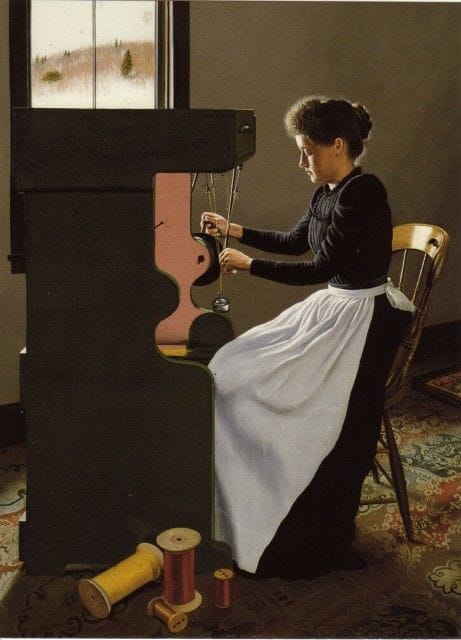

A Lady of Baptist Corner, Ashfield, Massachusetts, 1892
Edwin Romanzo Elmer
In the portrait of his wife operating a machine he invented to make whip snaps (the braided end of horsewhips), Elmer shows his love of detail - from the design of the carpet to the play of light and shadow in the scene.
[http://history927.rssing.com/chan-9198012/all_p6.html]
Edwin Romanzo Elmer was an American portrait, genre and still life painter. Known for his attention to detail, he was also an inventor of a machine for braiding horsewhips.
[https://en.wikipedia.org/wiki/Edwin_Romanzo_Elmer]
...Mary Elmer, working a machine that braids the silk ends of horsewhips. The subject was the artist's wife, and the machine was his own invention. The location was Ashfield, Massachusetts, not far from here. I like the light, and the snowy landscape, and her quiet face.
...He and his wife were described as "a gay and lively couple," but the author of the biography I have says:
Elmer does not, however, seem to have been a colorful town character about whom stories were told. Rather, he appears to have been the object of gentle condescension. People just didn't regard him as someone of importance. His origins in poverty and his limited education would have been known to all, but it was probably his lack of success at business that really determined the contemporary view of him. His art was interesting and unusual, but despite the frequent newspaper references it really didn't count, and in the eyes of his fellow townspeople he really didn't count either.
So all that seems a bit sad: only daughter dies, hand-to-mouth existence, never highly regarded . But here's why I find it heartening:
He did keep on doing his art--and other things as well--always trying. Going off to study art for a year when you're 49, as he did, shows a hopeful spirit. All his various ventures show, to my mind, engagement with the world and indefatigability. His portrait of his wife and the memorial to his daughter show affection. It seems like a good life--one with its share of sorrow, for sure, but full and rich in experiences if not money.
And decades after his death, his paintings are visible on the Internet, and I have postcards of them. It's not *great* fame, but his memory and his work live on.
[http://asakiyume.livejournal.com/539689.html]
Uploaded on Feb 12, 2018 by Suzan Hamer
Edwin Romanzo Elmer
artistArthur
Wait what?

